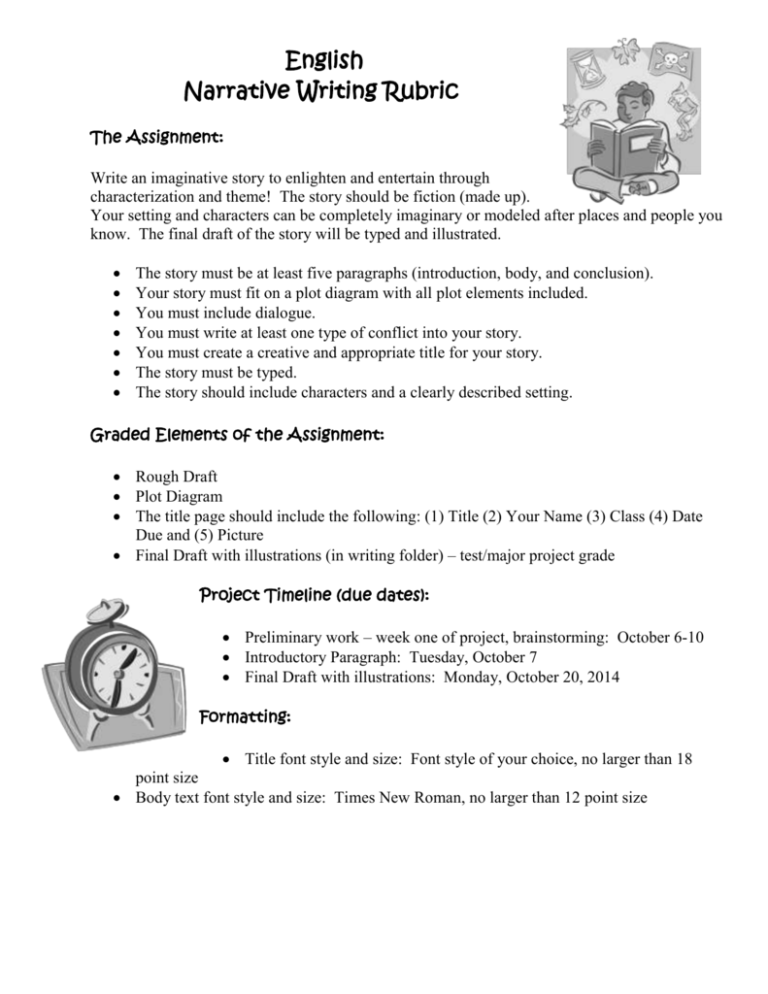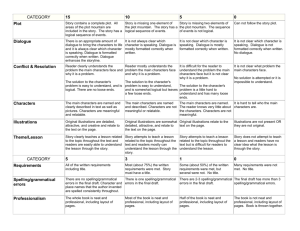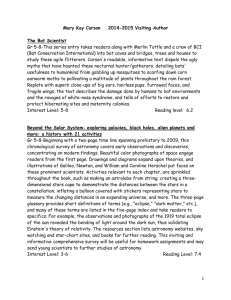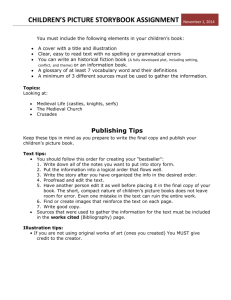Imaginative Story Rubric
advertisement

English Narrative Writing Rubric The Assignment: Write an imaginative story to enlighten and entertain through characterization and theme! The story should be fiction (made up). Your setting and characters can be completely imaginary or modeled after places and people you know. The final draft of the story will be typed and illustrated. The story must be at least five paragraphs (introduction, body, and conclusion). Your story must fit on a plot diagram with all plot elements included. You must include dialogue. You must write at least one type of conflict into your story. You must create a creative and appropriate title for your story. The story must be typed. The story should include characters and a clearly described setting. Graded Elements of the Assignment: Rough Draft Plot Diagram The title page should include the following: (1) Title (2) Your Name (3) Class (4) Date Due and (5) Picture Final Draft with illustrations (in writing folder) – test/major project grade Project Timeline (due dates): Preliminary work – week one of project, brainstorming: October 6-10 Introductory Paragraph: Tuesday, October 7 Final Draft with illustrations: Monday, October 20, 2014 Formatting: Title font style and size: Font style of your choice, no larger than 18 point size Body text font style and size: Times New Roman, no larger than 12 point size Imaginative Story Rubric Categories Title Characterization Setting Problem/ Conflict Organization Techniques Illustrations Conventions (Grammar and Spelling) 4= Exceeds Expectations 3=Meets Expectations Title is creative, sparks interest, and is related to the story or topic. Main characters are named and clearly described using a variety of direct and indirect techniques. Readers could describe the characters accurately. Many vivid, descriptive words (sensory) are used to tell when and where the story took place. Readers very easily understand the problem the main characters face and why. The story is well organized, using a logical sequence of events, elements of plot (exposition, rising, action, climax, falling action, resolution), and clear transitions. The writer used at least three literary devices to enhance the story. Illustrations are detailed, attractive, creative, and relate to the text on the story. The writer makes no errors in grammar or spelling that distract the reader from the story. 2=Below Expectations Title is related to the story and topic. 1=Minimal Effort Main characters are named and described using some direct and indirect techniques. Readers have some idea of what the readers are like. Title is present, but does not appear to be related to the story and topic. Main characters are named using few direct and indirect characterization techniques. Readers know very little about the characters. Some vivid, descriptive words (sensory) are used to tell the audience when and where the story took place. Readers understand the problem the main characters face and why. Readers can figure out when and where the story took place, but the writer did not supply much detail. Readers understand the problem, but it is not clear why it is a problem. The story is well organized. One idea or scene may seem out of place. Clear transitions are used. The story is a little hard to follow. The transitions are sometimes not clear. The story seems to be randomly arranged. The writer used at least two literary devices to enhance the story. Illustrations are somewhat detailed, attractive, and relate to the story. The writer used at least one literary device to enhance the story. Illustrations relate to the story. The story lacks literary devices. The writer makes one to two errors in grammar or spelling that distract the reader. The writer makes three to four errors in grammar or spelling that distract the reader. The writer makes more than four errors in grammar to spelling. Score No title. It is hard to tell who the main characters are and there is little or no use of direct or indirect characterization techniques. Readers have trouble figuring out when and where the story took place. It is not clear what problem the main characters face. Illustrations are not present or do not relate to the story. Points 32 31-29 28-26 25-23 22-21 20-19 18-17 16-14 13-11 10-8 Score 100 95 90 85 80 75 70 65 60 55 Total








